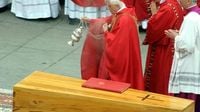The funeral ceremonies for Pope Francis will take place on Saturday, April 26, 2025, in a historic and simplified rite that reflects his values of humility and pastoral service. According to a new document published in November 2024, the updated rules replace those from 1998, which were used during the funerals of Pope John Paul II and Pope Benedict XVI. The changes aim to emphasize the Pope's role as a shepherd rather than a powerful leader of the Church.
As the world prepares to bid farewell to a beloved leader, the ceremonies will begin at 10:00 AM in St. Peter's Square, with Cardinal Giovanni Battista Re presiding over the mass. By 8:30 AM, delegations from around the globe, including notable figures such as President Donald Trump of the USA, President Volodymyr Zelensky of Ukraine, and Argentine President Javier Gerardo Milei, will take their seats. The seating arrangement has been meticulously planned, with the first row reserved for the delegation from Argentina, followed by representatives from Italy and various royal families.
In a departure from tradition, Pope Francis has opted for a simpler burial arrangement. His body will be placed in two coffins: one made of zinc and the other of oak, eliminating the third cypress coffin that was customary in previous papal funerals. This decision aligns with his wish to be buried in the Basilica of Saint Mary Major, rather than the Vatican Basilica, marking the first papal burial outside the Vatican in over a century.
Approximately 200,000 people are expected to attend the funeral mass, with about 40,000 individuals able to fit into St. Peter's Square. The area has been heavily secured, with law enforcement and volunteers ensuring safety amid the presence of numerous world leaders. The atmosphere is charged with emotion, as many mourners carry flags from their home countries, including Poland.
Pope Francis passed away on April 21, 2025, due to a stroke, coma, and circulatory failure. His death was confirmed in a private chapel, and his body was displayed in the House of Saint Martha before being transferred to St. Peter's Basilica. Unlike previous papal funerals, where the body was displayed on a catafalque, this time it was placed directly in the coffin.
The funeral will not only honor the late Pope's legacy but also highlight his commitment to humility. The title changes reflect this philosophy, returning to the terminology used in the Roman Missal from 2008: Pope, Bishop of Rome, and Shepherd. The new guidelines also take into account the current theological and ecclesiastical sensitivities, adapting the funeral rites to better suit the values of Pope Francis.
As the funeral procession moves from St. Peter's Square to the Basilica of Saint Mary Major, it will take approximately 30 minutes, traveling at a slow pace of 5-10 kilometers per hour. This allows many faithful to pay their last respects as the hearse passes. The procession will be accompanied by cardinals and relatives of Pope Francis, ensuring that the ceremony remains intimate even amidst the grandiosity of the occasion.
Upon arrival at the Basilica, Pope Francis will be welcomed by a unique gathering of individuals, including prisoners, the homeless, and transgender people, who will greet him with white roses. This poignant moment will be the last televised segment of the ceremony, as the final act of closing the tomb will be a private affair.
The entire ceremony is expected to conclude around 1:00 PM, marking the end of a significant chapter in the history of the Catholic Church. Pope Francis, known for his approachability and focus on the marginalized, leaves behind a legacy that resonates deeply with millions around the world.
Reflecting on the changes in papal funerals, it is noteworthy that the last Pope to be buried outside the Vatican Basilica was Pope Leo XIII in 1903. This shift in tradition underscores Pope Francis's desire to connect with the Church's faithful in a more profound manner, emphasizing his role as a servant leader.
As preparations continue, the Vatican remains a focal point for those wishing to honor Pope Francis's memory. His emphasis on simplicity and humility is expected to be a guiding principle throughout the ceremonies, reminding attendees of his life's work and dedication to serving others.
In conclusion, the funeral of Pope Francis is set to be a historic event that not only commemorates his life but also reflects his values of humility and service to the Church. As world leaders and faithful gather to pay their respects, the ceremonies promise to be a fitting tribute to a Pope who reshaped the Church's engagement with the modern world.





